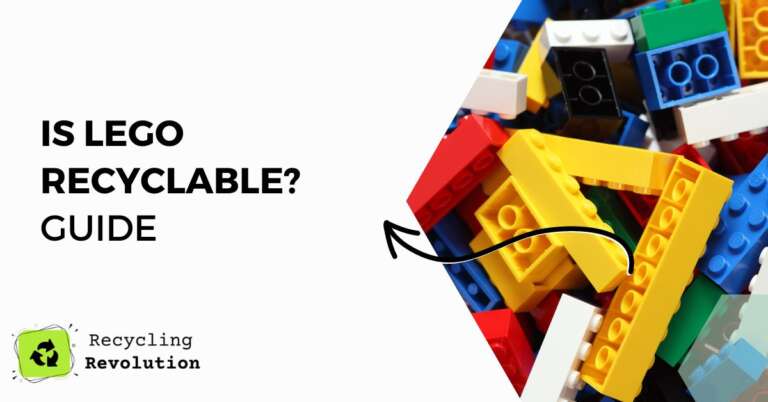The iconic Lego bricks, loved by children and adults worldwide, are made of plastic – a material notorious for its environmental impact. But did you know that these little blocks of joy could be recyclable too?
Today, I’ll take you on a journey of how Lego is recyclable, the environmental effects, and recommendations on handling Lego recycling.
TL;DR: Lego, though made of plastic, can be recycled under specific conditions. The company has taken considerable steps to promote recycling and sustainability. I recommend being cautious and informed about the recycling process, as Lego requires particular handling.
From Oil to Plastic to a Child’s Joy
Lego bricks are made from ABS (Acrylonitrile Butadiene Styrene), a common type of plastic derived from oil. In their manufacturing process, raw oil is converted into ABS granules, which are then moulded into the beloved Lego pieces we know.
The durability of ABS ensures Lego bricks can withstand years of play, but it also means they take a long time to degrade – up to hundreds of years in a landfill, according to studies.
How is Lego Recyclable?
While traditional recycling processes are not suitable for ABS plastics due to their composition, it’s still possible to recycle Lego bricks.
You might be surprised to learn that Lego has set up its recycling program. Called “Replay,” it collects and redistributes used Lego bricks. Here’s how it works:
- Collect your used Lego bricks.
- Wash them according to Lego’s instructions to ensure they are clean.
- Package them in a cardboard box.
- Use the free shipping label from the Lego Replay website to send them off.
Lego then sorts, cleans, and repackages the bricks to provide them to charities, thus extending the life of each piece and reducing the need for new bricks to be produced.
What are Lego Bricks made off
| Material | Biodegradable | Time to Degrade |
|---|---|---|
| ABS Plastic (Acrylonitrile Butadiene Styrene) | No | Hundreds to thousands of years |
| Bioplastic (Plant-based plastic) | Yes | Months to years, under industrial composting conditions |
The Environmental Impact
Manufacturing new Lego bricks is resource-intensive and has a significant environmental impact. A useful suggestion would be to consider the carbon footprint, water usage, and oil consumption associated with creating each brick. By recycling and reusing Lego bricks, we can significantly reduce these environmental impacts.
Additionally, Lego’s move to make its packaging more sustainable – using paper rather than plastic – can reduce the associated environmental impact by up to 10%, according to a study by the Danish Environmental Protection Agency.
Lego and Sustainability: The Path Forward
Lego has been taking steps towards sustainability, committing to using sustainable materials in their core products and packaging by 2030. They are also investing in wind power, aiming to offset the carbon emissions associated with their operations.
Lego Alternatives
While Lego’s efforts towards sustainability and recycling are commendable, it might be worthwhile to consider other environmentally friendly alternatives to traditional Lego bricks:
- Bioplastic Lego: Lego has started producing pieces made from plant-based plastic sourced from sugarcane, showing promising steps towards sustainability.
- Eco-Bricks: These are a fantastic alternative, made from biodegradable materials and designed to be compatible with traditional Lego bricks.
Ideas on What to Do With old Lego
Here’s how you can give new life to your old Lego bricks:
1. Lego Replay Program: As mentioned earlier, Lego has a wonderful program where you can donate your used Lego bricks. They clean, sort, and give the bricks a new home with children who can continue the play.
2. Donate: Consider donating your used Lego bricks to local schools, libraries, or children’s hospitals. Many institutions would gladly accept them for educational and therapeutic purposes.
3. Sell or Trade: There are numerous online platforms where you can sell or trade your old Lego sets. Websites like eBay, BrickLink, and even social media groups have active communities of Lego enthusiasts who might be looking for the pieces you have.
4. Lego Art: Old Lego bricks can be turned into creative art projects. From picture frames to intricate sculptures, the possibilities are endless. It’s a great way to repurpose Lego while also engaging in a fun and creative activity.
5. Storage: I recommend storing old Lego for the future. Lego bricks are incredibly durable and stand the test of time. They can be passed on to younger family members in the future.
6. Upcycle: Think outside the box and use old Lego bricks for practical purposes around the house. They can be used to make key holders, cable organizers, coasters, and even garden planters.
Conclusion
Recycling Lego can be a simple yet effective way to reduce environmental impact. By participating in initiatives like Lego Replay and seeking out sustainable alternatives, we can enjoy our favourite childhood toy while protecting our planet. Let’s build a sustainable future, one brick at a time.
FAQs
Can I recycle Lego in my home recycling bin?
No. Lego bricks require special recycling due to their ABS plastic composition. Use the Lego Replay program instead.
Can all Lego pieces be recycled through the Replay program?
Currently, the program accepts all previously played Lego bricks. Other products like Lego Technic or Duplo are not accepted.
What happens to the Lego bricks I send for recycling?
The bricks are cleaned, sorted, and repackaged to be given to charities, thus reducing the need for new production.

